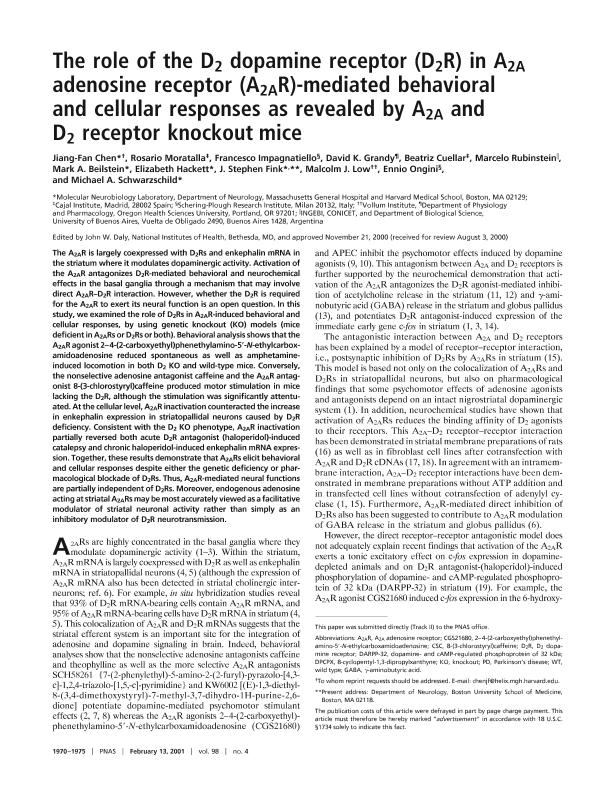Mostrar el registro sencillo del ítem
dc.contributor.author
Chen, Jiang Fan
dc.contributor.author
Moratalla, Rosario
dc.contributor.author
Impagnatiello, Francesco
dc.contributor.author
Grandy, David K.

dc.contributor.author
Cuellar, Beatriz
dc.contributor.author
Rubinstein, Marcelo

dc.contributor.author
Beilstein, Mark A.
dc.contributor.author
Hackett, Elizabeth
dc.contributor.author
Fink, J. Stephen
dc.contributor.author
Low, Malcolm J.

dc.contributor.author
Ongini, Ennio
dc.contributor.author
Schwarzschild, Michael A.
dc.date.available
2019-03-18T19:48:59Z
dc.date.issued
2001-02
dc.identifier.citation
Chen, Jiang Fan; Moratalla, Rosario; Impagnatiello, Francesco; Grandy, David K.; Cuellar, Beatriz; et al.; The role of the D2 dopamine receptor (D2R) in A2A adenosine receptor (A2AR)-mediated behavioral and cellular responses as revealed by A2A and D2 receptor knockout mice; National Academy of Sciences; Proceedings of the National Academy of Sciences of The United States of America; 98; 4; 2-2001; 1970-1975
dc.identifier.issn
0027-8424
dc.identifier.uri
http://hdl.handle.net/11336/71920
dc.description.abstract
The A2AR is largely coexpressed with D2Rs and enkephalin mRNA in the striatum where it modulates dopaminergic activity. Activation of the A2AR antagonizes D2R-mediated behavioral and neurochemical effects in the basal ganglia through a mechanism that may involve direct A2AR-D2R interaction. However, whether the D2R is required for the A2AR to exert its neural function is an open question. In this study, we examined the role of D2Rs in A2AR-induced behavioral and cellular responses, by using genetic knockout (KO) models (mice deficient in A2ARs or D2Rs or both). Behavioral analysis shows that the A2AR agonist 2-4-(2-carboxyethyl)phenethylamino-5′-N-ethylcarboxamidoadenosine reduced spontaneous as well as amphetamine-induced locomotion in both D2 KO and wild-type mice. Conversely, the nonselective adenosine antagonist caffeine and the A2AR antagonist 8-(3-chlorostyryl)caffeine produced motor stimulation in mice lacking the D2R, although the stimulation was significantly attentuated. At the cellular level, A2AR inactivation counteracted the increase in enkephalin expression in striatopallidal neurons caused by D2R deficiency. Consistent with the D2 KO phenotype, A2AR inactivation partially reversed both acute D2R antagonist (haloperidol)-induced catalepsy and chronic haloperidol-induced enkephalin mRNA expression. Together, these results demonstrate that A2ARs elicit behavioral and cellular responses despite either the genetic deficiency or pharmacological blockade of D2Rs. Thus, A2AR-mediated neural functions are partially independent of D2Rs. Moreover, endogenous adenosine acting at striatal A2ARs may be most accurately viewed as a facilitative modulator of striatal neuronal activity rather than simply as an inhibitory modulator of D2R neurotransmission.
dc.format
application/pdf
dc.language.iso
eng
dc.publisher
National Academy of Sciences

dc.rights
info:eu-repo/semantics/openAccess
dc.rights.uri
https://creativecommons.org/licenses/by-nc-sa/2.5/ar/
dc.subject
Dopamina
dc.subject
Adenosina
dc.subject.classification
Inmunología

dc.subject.classification
Medicina Básica

dc.subject.classification
CIENCIAS MÉDICAS Y DE LA SALUD

dc.title
The role of the D2 dopamine receptor (D2R) in A2A adenosine receptor (A2AR)-mediated behavioral and cellular responses as revealed by A2A and D2 receptor knockout mice
dc.type
info:eu-repo/semantics/article
dc.type
info:ar-repo/semantics/artículo
dc.type
info:eu-repo/semantics/publishedVersion
dc.date.updated
2019-03-14T14:16:12Z
dc.journal.volume
98
dc.journal.number
4
dc.journal.pagination
1970-1975
dc.journal.pais
Estados Unidos

dc.journal.ciudad
Washington DC
dc.description.fil
Fil: Chen, Jiang Fan. Harvard Medical School; Estados Unidos. Massachusetts General Hospital; Estados Unidos
dc.description.fil
Fil: Moratalla, Rosario. Instituto Cajal; España
dc.description.fil
Fil: Impagnatiello, Francesco. Schering-Plough Research Institute; Italia
dc.description.fil
Fil: Grandy, David K.. University of Oregon; Estados Unidos
dc.description.fil
Fil: Cuellar, Beatriz. Instituto Cajal; España
dc.description.fil
Fil: Rubinstein, Marcelo. Consejo Nacional de Investigaciones Científicas y Técnicas. Instituto de Investigaciones en Ingeniería Genética y Biología Molecular "Dr. Héctor N. Torres"; Argentina
dc.description.fil
Fil: Beilstein, Mark A.. Harvard Medical School; Estados Unidos. Massachusetts General Hospital; Estados Unidos
dc.description.fil
Fil: Hackett, Elizabeth. Harvard Medical School; Estados Unidos. Massachusetts General Hospital; Estados Unidos
dc.description.fil
Fil: Fink, J. Stephen. Harvard Medical School; Estados Unidos. Massachusetts General Hospital; Estados Unidos. Boston University; Estados Unidos
dc.description.fil
Fil: Low, Malcolm J.. University of Oregon; Estados Unidos
dc.description.fil
Fil: Ongini, Ennio. Schering-Plough Research Institute; Italia
dc.description.fil
Fil: Schwarzschild, Michael A.. Harvard Medical School; Estados Unidos. Massachusetts General Hospital; Estados Unidos
dc.journal.title
Proceedings of the National Academy of Sciences of The United States of America

dc.relation.alternativeid
info:eu-repo/semantics/altIdentifier/doi/http://dx.doi.org/10.1073/pnas.98.4.1970
dc.relation.alternativeid
info:eu-repo/semantics/altIdentifier/url/https://www.ncbi.nlm.nih.gov/pmc/articles/PMC29366/
dc.relation.alternativeid
info:eu-repo/semantics/altIdentifier/url/https://www.pnas.org/content/98/4/1970
Archivos asociados
